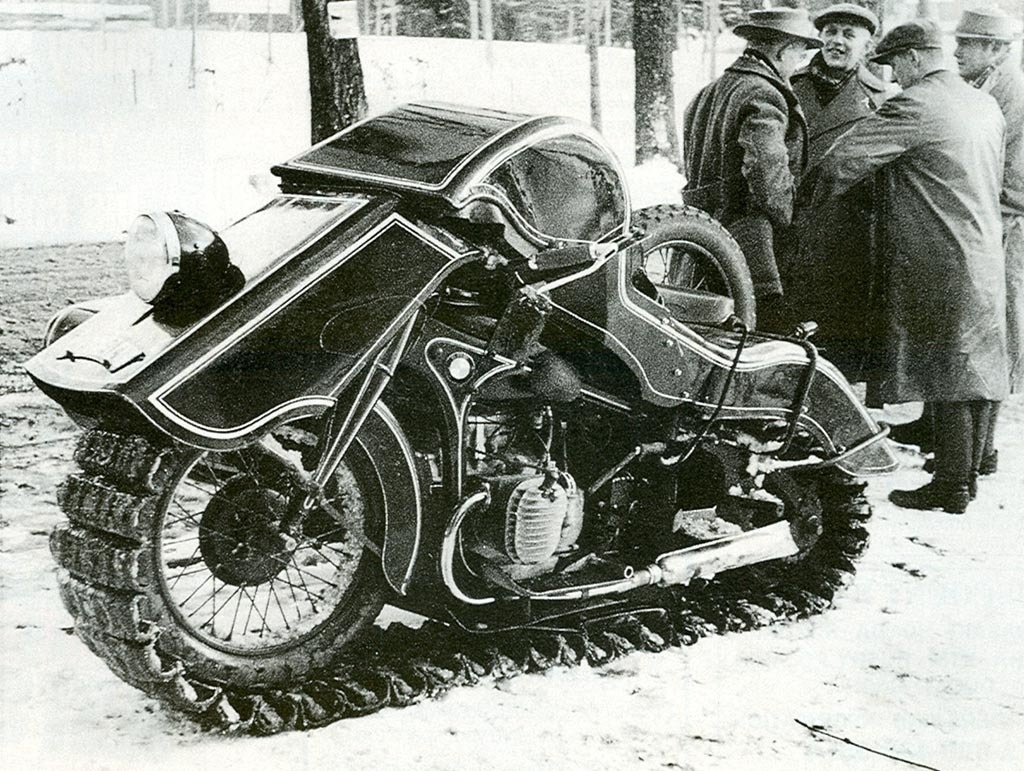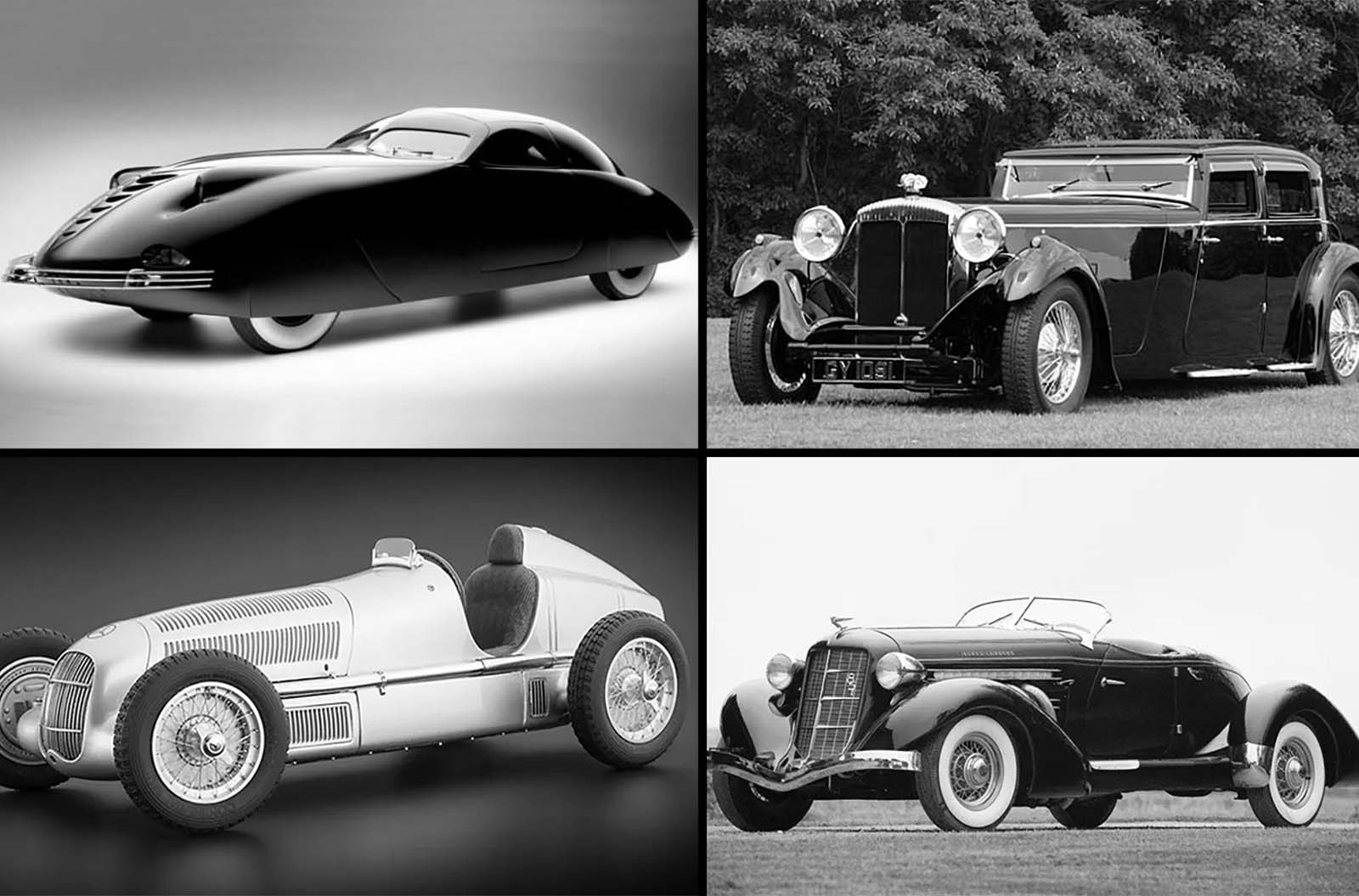
The 1930s was a decade that produced some of the most iconic and beautiful cars in automotive history. These cars were built during a time when design was king and manufacturers were pushing the limits of engineering and creativity.
From the sleek lines of the Bugatti Type 57SC Atlantic to the luxurious curves of the Cadillac V16, the cars of the 1930s were truly works of art.
In this article, we’ll take a look back at some of the most beautiful cars of the 1930s. We’ll explore the design elements that made these cars so special, from the long hoods and flowing fenders to the intricate details and luxurious finishes. We’ll also delve into the history of each car, examining how they were built and what made them stand out from the crowd.
Whether you’re a car enthusiast or simply appreciate beautiful design, these vintage photos are sure to captivate your imagination and transport you back to a time when the automobile was more than just a means of transportation – it was a symbol of status and style.
Rolls-Royce Phantom I Jonckheere Coupe (1925)
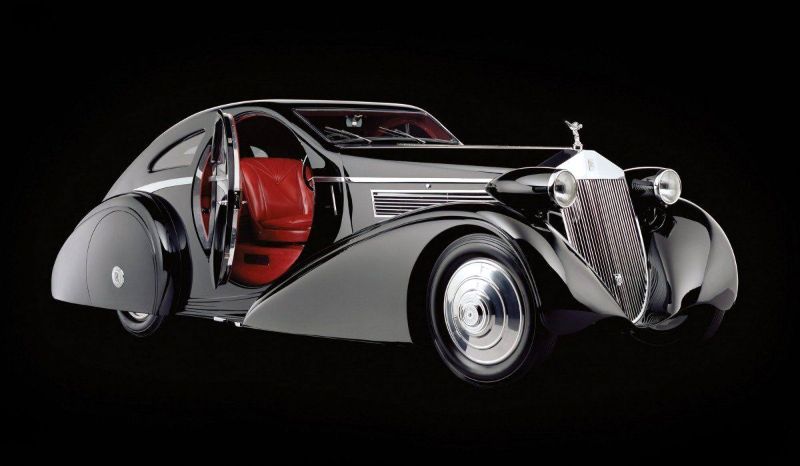
Rolls-Royce Phantom I Jonckheere Coupe, 1925. (Photo by Scott Williamson).
The Rolls-Royce Phantom I Jonckheere Coupe is a legendary automobile renowned for its unique and stunning design. The car was created by Belgian coachbuilder Jonckheere in 1935 and was based on a 1925 Rolls-Royce Phantom I chassis.
The design of the Phantom I Jonckheere Coupe is characterized by its aerodynamic and futuristic shape, which was considered avant-garde for its time.
The car’s sleek, elongated body featured a tapered rear end, a pointed nose, and a low roofline that gave it a sporty and aggressive appearance.
One of the most striking features of the car is its large, curved windscreen, which seamlessly blends into the roof and gives the impression of a single, uninterrupted piece of glass. The car’s bodywork is made entirely of aluminum, which allowed Jonckheere to achieve the car’s distinctive curves and contours.
Inside, the Phantom I Jonckheere Coupe features a luxurious and opulent interior, with sumptuous leather seats, plush carpets, and an array of chrome and wood accents.
The car was designed as a one-off creation for a wealthy European family, and as such, no two Jonckheere Coupes are exactly alike.
Bugatti Type 35B Grand Prix (1925)

Bugatti Type 35B Grand Prix, 1925.
The Bugatti Type 35 is an iconic race car design produced by Bugatti at their Molsheim premises between 1924 and 1930. It was extremely successful when raced by the factory works team.
It was also bought by a diverse roster of privateer clientele from around the world. It pioneered the concept of a holistically conceived, race-ready car available for purchase.
The arch/egg-shaped radiator is emblematic, as is the rear of the car. The tapered stern has been called a ‘Bordino tail’ and Ettore Bugatti may have been influenced by the shape of the earlier Fiat 804 driven and modified by Pietro Bordino. The car has also become synonymous with being the first to use cast alloy wheels.
The Type 35 was phenomenally successful, winning over 1,000 races in its time. It took the Grand Prix World Championship in 1926 after winning 351 races and setting 47 records in the two prior years.
At its height, Type 35 averaged 14 race wins per week. Bugatti won the Targa Florio for five consecutive years, from 1925 through 1929, with the Type 35.
Duesenberg Model J (1928)
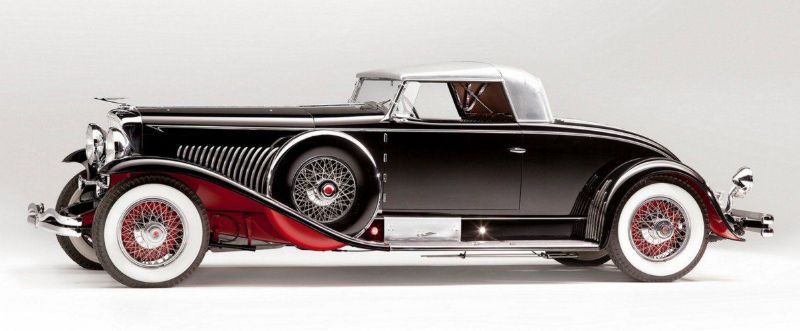
Duesenberg Model J, 1928.
The Duesenberg Model J was a luxury automobile produced by the Duesenberg Automobile & Motors Company from 1928 to 1937.
The car was powered by a massive 6.9-liter straight-eight engine that produced 265 horsepower, making it one of the most powerful cars of its time. It could reach speeds of up to 119 miles per hour, which was a remarkable achievement for a car of that era.
The Model J was known for its opulent styling and luxurious amenities, which included a custom-built body, plush interiors, and advanced engineering features such as hydraulic brakes and four-wheel independent suspension.
Its elegant design and exceptional performance made it a favorite among Hollywood celebrities, wealthy socialites, and industrial tycoons.
Despite its high price tag, the Duesenberg Model J was a commercial success, with approximately 480 units produced during its production run.
Mercedes-Benz 710 SSK Trossi Roadster (1930)

Mercedes-Benz 710 SSK Trossi Roadster, 1930.
The 710 SSK Trossi Roadster was designed by Carlo Felice Trossi, an Italian racing driver and engineer, in collaboration with the Mercedes-Benz design team. It was based on the Mercedes-Benz SSK sports car, which was already a high-performance machine in its own right.
The Trossi Roadster was powered by a 7.1-liter supercharged inline-six engine that produced 300 horsepower, making it one of the most powerful cars of its era.

Mercedes-Benz 710 SSK Trossi Roadster.
Its advanced engineering features included a four-speed manual transmission, hydraulic brakes, and a torsion bar suspension system.
But what truly set the Trossi Roadster apart was its stunning design. Its long hood, flowing lines, and low-slung body gave it a sleek and aerodynamic appearance that was unlike anything else on the road at the time.
The car’s unique styling elements, such as the vertical grille and the exposed spare tire, became defining features of the Mercedes-Benz brand.
Mercedes-Benz W25 Silver Arrow (1934)
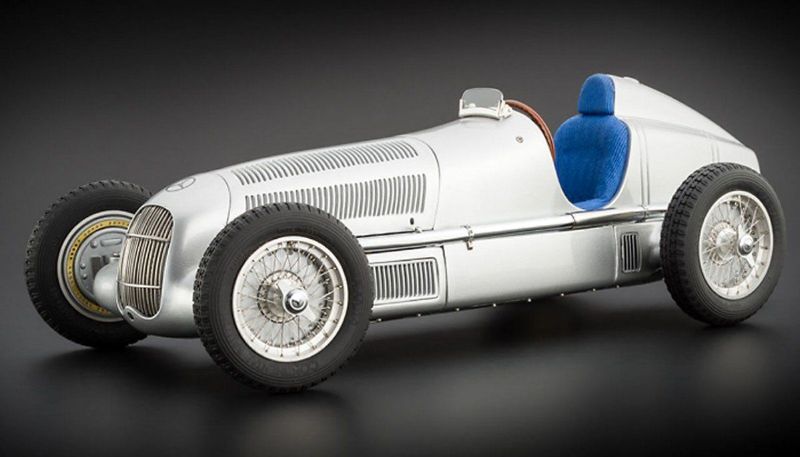
Mercedes-Benz W25 Silver Arrow, 1934.
The Mercedes-Benz W25 was a Grand Prix racing car designed by Daimler-Benz AG for the 1934 Grand Prix season, in which new rules were introduced, and no championship was held.
In 1935, the European Championship was resumed, and it was won by Rudolf Caracciola in a W25. In modified form, the W25 remained in use until 1937, when it was succeeded by the Mercedes-Benz W125.
Citroën Traction Avant (1934)
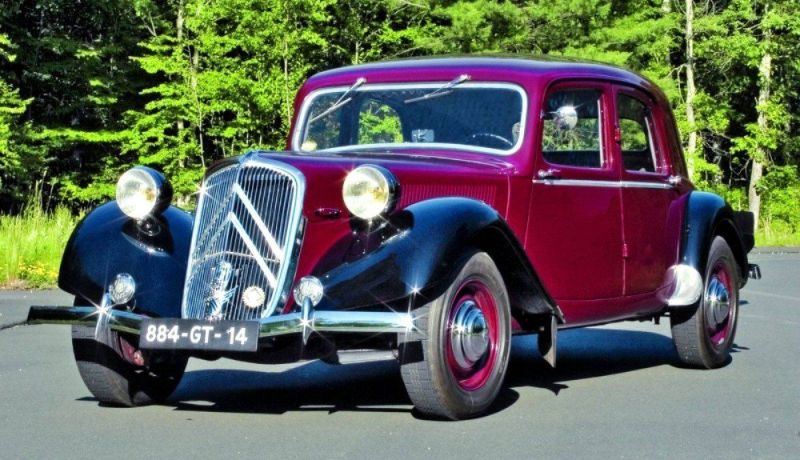
Citroën Traction Avant, 1934.
The Citroën Traction Avant is the world’s first unibody front-wheel-drive car. A range of mostly 4-door saloons and executive cars, were made with four or six-cylinder engines, produced by the French manufacturer Citroën from 1934 to 1957. Approximately 760,000 units were produced.
Whilst front-wheel drive and four-wheel independent suspension had been established in the mass market by Auto Union and subsequently others some years before, the Traction Avant pioneered integrating these into a mass-production, crash-resistant, unitary, monocoque body. Additionally, the car was also an early adopter of rack and pinion steering.
Although the car’s name emphasized its front-wheel drive power delivery (“Traction Avant” literally means “front traction”), the car stood out at least as much by its much lower profile and stance – made possible by the absence of a separate chassis under the car’s unitary body – sharply distinguishing it visually from its contemporaries.
Auburn 851 SC Boattail Speedster (1935)
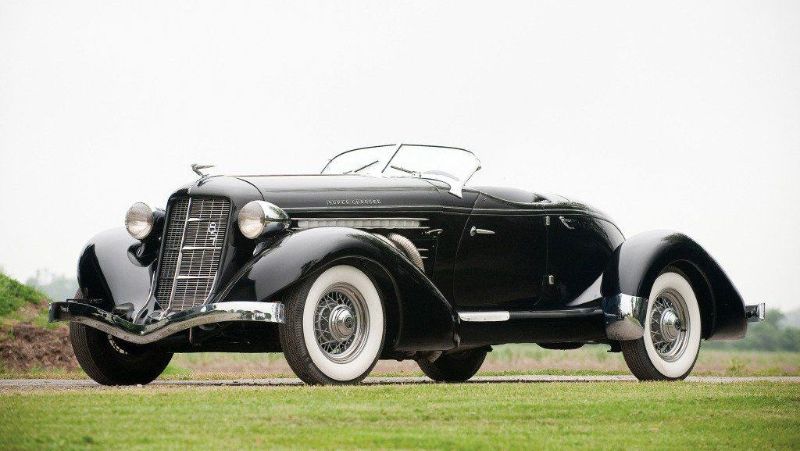
Auburn 851 SC Boattail Speedster, 1935.
The Auburn Speedster was an American car, manufactured by the Auburn Automobile Company of Auburn, Indiana, and manufactured in Union City, Indiana.
A total of 887 cars were manufactured between 1928 and 1936, across 3 series (1928-1930 with “eight” and “big eight” engines, the V12 series from 1931 to 1934, and the dramatic, iconic 1935-36 Supercharged 8 ).
A water-cooled inline-eight 4,6-liter engine developed up to 150 hp, allowing the Speedster to reach a max speed of 104 mph (167 km/h).
The first two series were designed by stylist Alan Leamy. The Auburn 851 Speedster of 1935 was styled by designer Gordon Buehrig, who also was responsible for the Cord Model 810. Al Jenkins broke 70 America speed records in the 1935 car.
Mercedes-Benz 540K Special Roadster (1936)
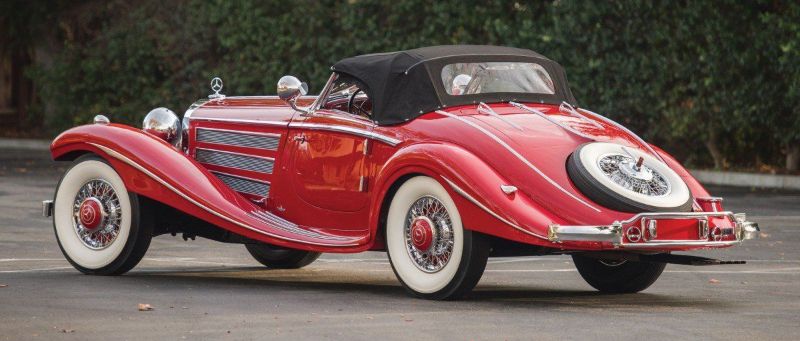
Mercedes-Benz 540K Special Roadster, 1936.
Designed by Friedrich Geiger, a German designer who gave us automotive gems like the Mercedes-Benz 300SL Gullwing, Mercedes-Benz W113 “Pagoda” and Mercedes-Benz 600 limousine, the 540K Special was built in only 32 examples.
Sporting a supercharged 5.4-liter inline eight that developed up to 180 hp, it wasn’t some of the fastest cars available. It was, however, one of the largest, most luxurious, and most expensive cars you could buy in the ’30s.
In 1937, Reichsmarschall Hermann Goering ordered a 540K, in his favorite color of “Luftwaffe” blue with his family crest on both doors. It included armor-plated sides and bulletproof glass. Nicknamed the “Blue Goose”, Goering was often photographed in the car.
On May 4, 1945, the US Army, C Company, 326th Engineers, 101st Airborne Division ‘Screaming Eagles’ entered Berchtesgaden, and on finding the car took possession.
Major General Maxwell Taylor used the car as his command vehicle in West Germany until it was commissioned by the US Treasury. Shipped to Washington, D.C., it successfully toured the United States in a victory bond tour.
In 1956, the car was auctioned off by the US Army at the Aberdeen Proving Grounds in Maryland and sold to Jacques Tunick of Greenwich, Connecticut, with a high bid of $2167.
Auto Union Type C (1936)
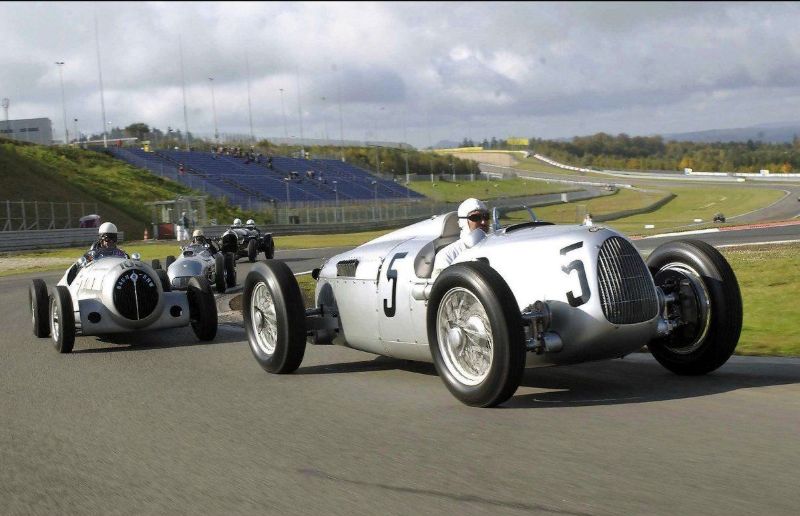
Auto Union Type C, 1936.
The Auto Union Grand Prix racing cars types A to D were developed and built by a specialist racing department of Auto Union’s Horch works in Zwickau, Germany, between 1933 and 1939, after the company bought a design by Dr. Ferdinand Porsche in 1933.
Of the 4 Auto Union racing cars, the Types A, B, and C, used from 1934 to 1937 had supercharged V16 engines, and the final car, the Type D used in 1938 and 1939 (built to new 1938 regulations), had a supercharged 3L V12 that developed almost 550 horsepower.
All of the designs were difficult to handle due to extreme power/weight ratios (wheelspin could be induced at over 100 mph (160 km/h)), and marked oversteer due to uneven weight distribution (all models were tail heavy). The Type D was easier to drive because of its smaller, lower mass engine that was better positioned toward the vehicle’s center of mass.
Between 1935 and 1937, Auto Unions won 25 races, driven by Ernst von Delius, Tazio Nuvolari, Bernd Rosemeyer, Hans Stuck, and Achille Varzi. Auto Union proved particularly successful in the 1936 and 1937 seasons.
Their main competition came from the Mercedes Benz team, which also raced sleek, silver cars. Known as the Silver Arrows, the cars of the two German teams dominated Grand Prix racing until the outbreak of World War II in 1939.
Talbot Lago T150C SS Goutte d’Eau (1937)
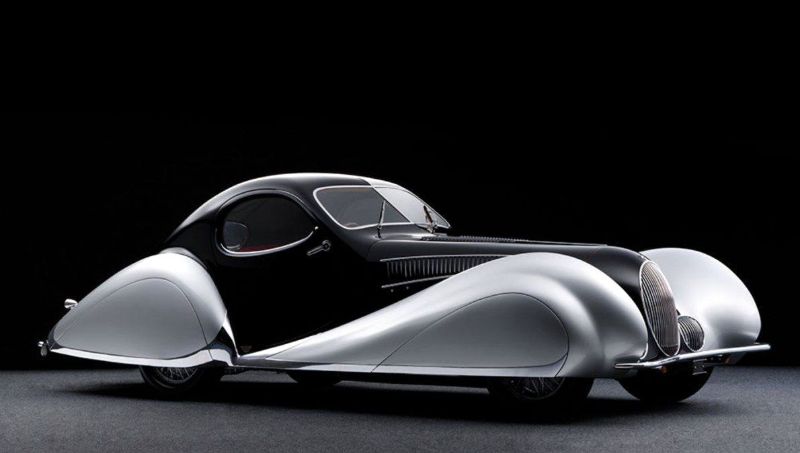
Talbot Lago T150C SS Goutte d’Eau, 1937.
Without a doubt one of the most beautiful cars ever made, the Talbot-Lago Teardrop Coupé was designed by Giuseppe Figoni, one of the greatest French coachbuilders before World War II.
The sheer definition of Art-Deco, the T150C SS was nicknamed Goutte d’Eau (teardrop) because of its round shape and sensual curves.
Not just a pretty car, though, as the Talbots of the era won many races, including the French Grand Prix of 1937. A stock Talbot Teardrop even competed at the 1938 24 of Le Mans race, placing third overall.
Bugatti Type 57SC Atlantic (1937)
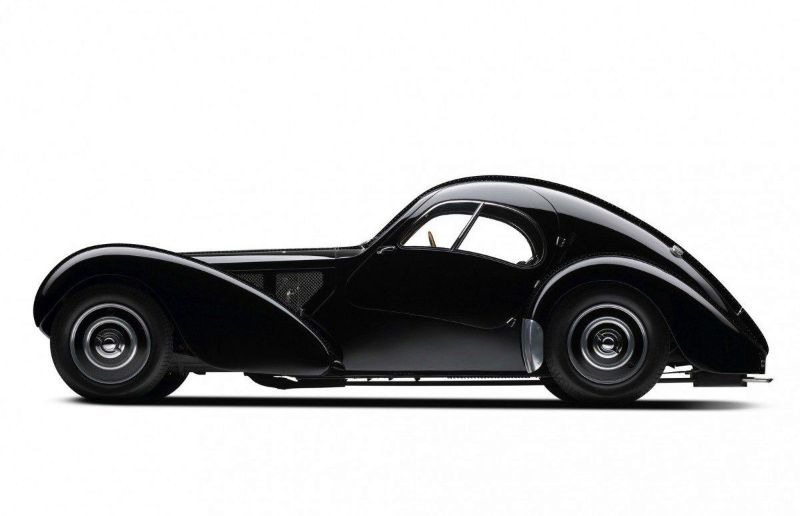
Bugatti Type 57SC Atlantic, 1937.
Bugatti Type 57SC Atlantic managed a top speed of 124 mph (200 km/h) in 1937 and was built in only four units, out of which only three continue to exist.
Its supercharged inline-eight 3.3-liter engine developed 210 hp, and its aluminum and wood body meant the car was extremely light (953 kg), with more than 220hp per ton.
The Atlantic models were developed from the unique Aérolithe prototype, also known as Coupé Special or Coupé Aero.
For this model, with chassis number 57 104, Jean Bugatti used Elektron sheet from aviation for the body. Elektron is an alloy of 90 percent magnesium and 10 percent aluminum.
Although it is lightweight and strong, it is difficult to work and cannot be welded, which is why Bugatti riveted the body parts together, creating the famous dorsal seam. For the “production” Atlantic, Bugatti used aluminum but retained the rivets on the dorsal seam.
The model is named in honor of Bugatti’s friend Jean Mermoz. The pioneering aviator was the first to cross the South Atlantic by air. He did not return from a South Atlantic crossing in 1936.
Alfa Romeo 8C 2900 B Mille Miglia (1938)
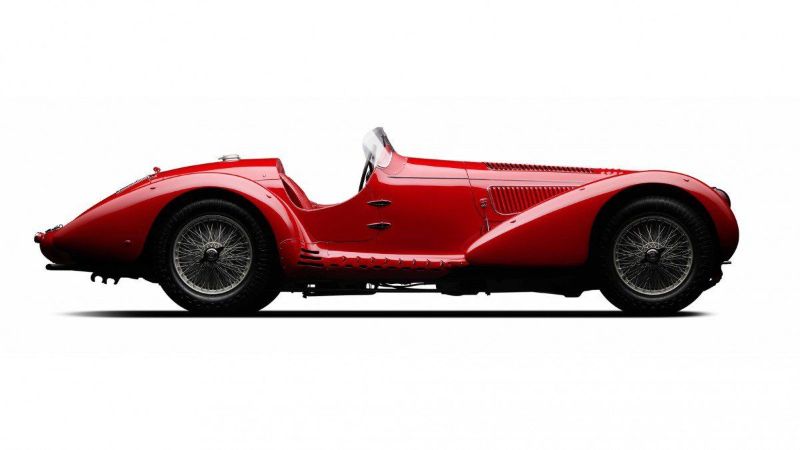
Alfa Romeo 8C 2900 B Mille Miglia, 1938.
The Alfa Romeo 8C was originally a range of Alfa Romeo road, race, and sports cars of the 1930s. The 8C designates 8 cylinders, and originally a straight 8-cylinder engine.
The Vittorio Jano designed 8C was Alfa Romeo’s primary racing engine from its introduction in 1931 to its retirement in 1939.
In addition to the two-seater sports cars it was used in the world’s first genuine single-seat Grand Prix racing car, the Monoposto ‘Tipo B’ – P3 from 1932 onwards.
In its later development, it powered such vehicles as the twin-engined 1935 6.3-liter Bimotore, the 1935 3.8-liter Monoposto 8C 35 Type C, and the Alfa Romeo 8C 2900B Mille Miglia Roadster. It also powered top-of-the-range coach-built production models, including a Touring Spider and Touring Berlinetta.
Daimler Double-Six (1932)

Daimler Double-Six, 1932.
Daimler Double-Six piston engine was a sleeve-valve V12 engine manufactured by The Daimler Company Limited of Coventry, England between 1926 and 1938 in four different sizes for their flagship cars.
From 1929 Daimler Double-Sixes were distinguishable from the six-cylinder cars by a chromium bar down the center of the radiator. A similar distinguishing mark was placed on the later Jaguar-made versions.
This engine was designed by consultant Chief Engineer L H Pomeroy (1883-1941) to achieve high power with quietness and, particularly, smoothness.
Pomeroy made the engine by taking the cylinder blocks of two existing 25/85 hp Daimler engines and putting them on a common crankcase.
Talbot Lago T150 SS Figoni & Falaschi Teardrop Coupe (1937)
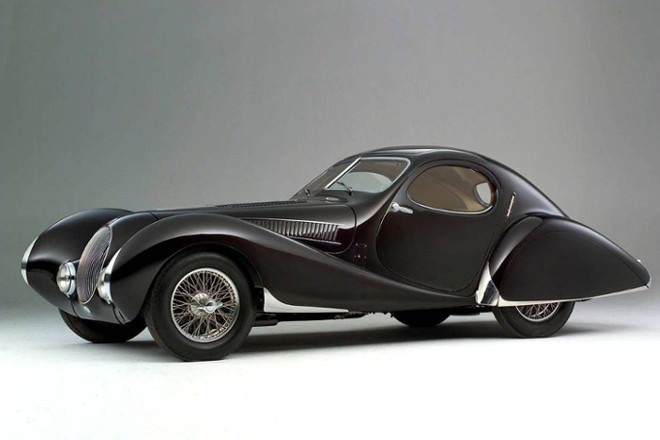
Talbot Lago T150 SS Figoni & Falaschi Teardrop Coupe, 1937.
The Talbot Lago T150 SS Figoni & Falaschi Teardrop Coupe is a vintage car that was produced in France from 1937 to 1955. The car was designed by Joseph Figoni and Ovidio Falaschi, who were renowned for their innovative and aerodynamic designs.
The Teardrop Coupe was powered by a 3.0-liter, six-cylinder engine that produced 140 horsepower. This gave the car a top speed of around 115 mph.
The car featured a sleek, streamlined body that was designed to minimize drag and improve performance. The body was made of lightweight aluminum, which also helped to reduce the car’s weight.
The Teardrop Coupe was widely regarded as one of the most beautiful cars of its time. It won numerous awards for its design and performance, including the Grand Prix d’Honneur at the 1937 Concours d’Elegance.
Phantom Corsair (1937)
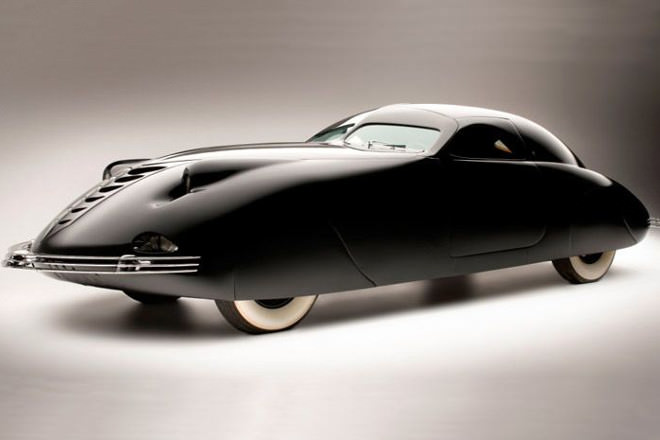
Phantom Corsair, 1937.
The Phantom Corsair is a prototype automobile built in 1938. It is a six-passenger 2-door sedan that was designed by Rust Heinz of the H. J. Heinz family and Maurice Schwartz of the Bohman & Schwartz coachbuilding company in Pasadena, California.
Although sometimes dismissed as a failure because it never entered production, the Corsair is regarded as ahead of its time because of its futuristic features, and styling cues such as faired-in fenders and a low profile.
The Corsair’s body was mated to the “most advanced chassis available in the United States” at that time, the Cord 810.
The Lycoming 80 V-8 engine-powered Cord chassis also featured front-wheel drive and an electrically operated four-speed pre-selector gearbox, as well as fully independent suspension and adjustable shock absorbers.
Though weighing a hefty 4,600 lb (2,100 kg), the Phantom Corsair could achieve speeds of up to 115 mph (185 km/h) because of its modified, naturally aspirated 125 bhp Lycoming engine as well as its aerodynamic shape.
(Photo credit: Wikimedia Commons / DriveMag / Gentleman’s Journal / Pinterest / Flickr).
